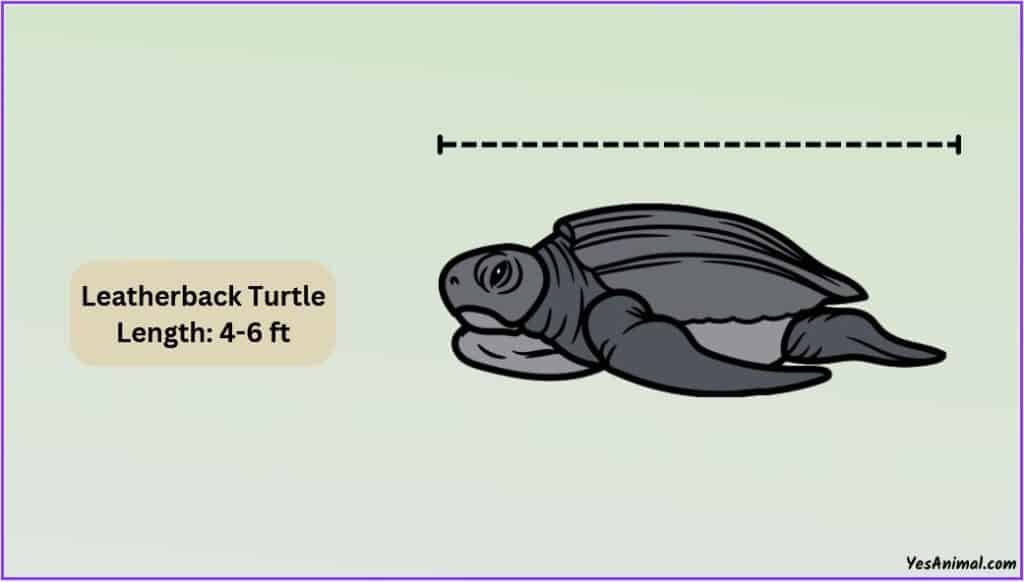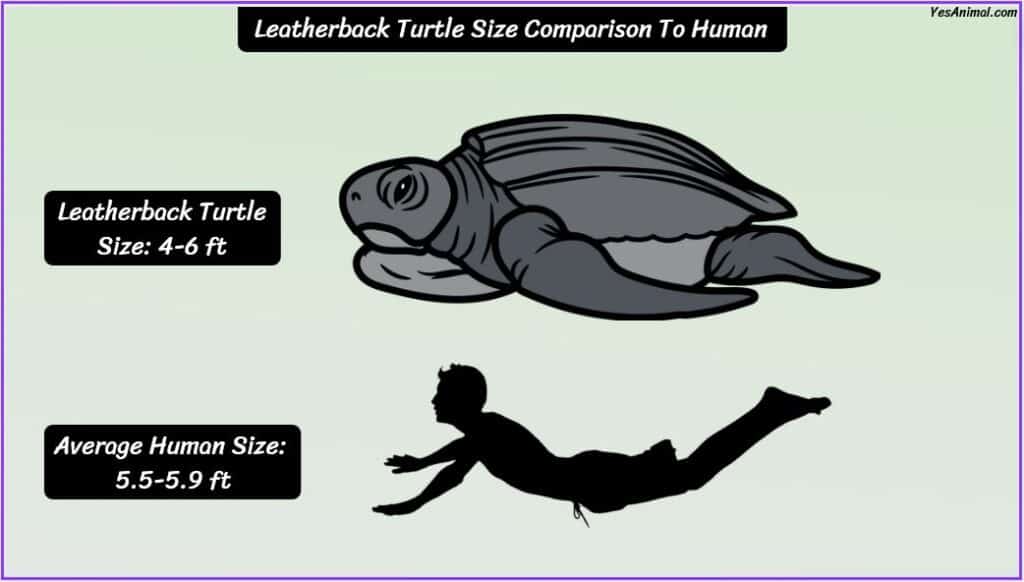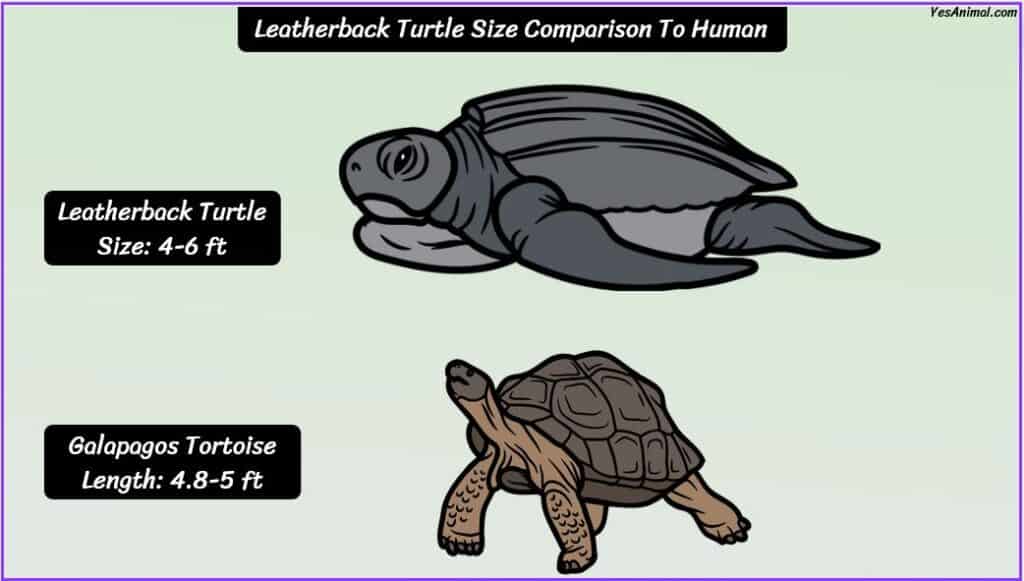Last Updated on April 11, 2023 by Amin Tawar
Leatherback Turtle Length

Leatherback turtles are found in the Pacific, Atlantic, and Indian Oceans, and are known for their long migrations and ability to dive to great depths. They have been found as far north as Alaska and as far south as Chile, and have been known to migrate across entire oceans.
Overall, Leatherback turtles are a true marvel of nature, with their impressive size and ability to migrate great distances. Their unique shells and gentle nature make them a species worth protecting for future generations to enjoy.
In terms of their size, Leatherback turtles are the largest turtles on earth, with a length of up to 4 to 6 feet (130 – 183 cm). Moreover, the largest leatherback ever measured was nearly 10 feet (305 cm) from the tip of its beak to the tip of its tail.
| Leatherback Turtle Length | Centimeter | Feet |
| Average | 130 – 183 cm | 4 to 6 feet |
| Maximum | 305 cm | 10 feet |
Despite their size and power, leatherback turtles are gentle giants and play a vital role in marine ecosystems. They help to control populations of jellyfish, and their feces provide nutrients to the ocean floor.
Leatherback Turtle Weight
Moving on to the weight of the Leatherback turtles, we can be sure of one thing they are not at all lightweight! The weight of leatherback turtles is a testament to their strength and resilience.
The impressive size of leatherback turtles is due in part to their diet, which consists primarily of jellyfish. These turtles have developed specialized adaptations to feed on this slippery prey, including backward-pointing spines on their tongues and a gular pouch in their throat to help hold onto the jellyfish.
As a result, the largest turtles on earth are leatherbacks, which can on average weigh up to 660 to 1,100 pounds (300 – 500 kg). On the other hand, the largest of them can even weigh up to 1,540 lb (700 kg).
| Leatherback Turtle weight | Kilograms | Pounds |
| Average | 300 – 500 kg | 660 to 1,100 pounds |
| Maximum | 700 kg | 1,540 lb |
Leatherback Turtle Egg & Clutch Size
Leatherback turtles are known for laying large numbers of eggs in a single clutch. The eggs are oval-shaped and are about the size of a ping pong ball, with an average of around 80 eggs per clutch. However, the size of the clutch can vary greatly, with some females laying as few as 20 eggs and others laying over 100.
After laying their eggs, female leatherback turtles will cover them with sand and then return to the ocean. The eggs will incubate for about 60-70 days before hatching. Once the eggs hatch, the baby turtles, or hatchlings, will make their way to the water using the moonlight to guide them.
Despite the large size of the eggs, the survival rate for leatherback turtle eggs and hatchlings is quite low, with many falling prey to predators such as birds, crabs, and other animals. Only a small percentage of the eggs laid will survive to become adult turtles. 1
Leatherback Turtle Baby Size
Till now we have been talking about adult Leatherback turtles, but have you ever thought of the young ones of these species?
If not then let me tell you, as said earlier, Leatherback turtles are the largest of all turtle species. However, when they are born, leatherback turtle hatchlings are just a fraction of this size, measuring only about 2 to 3 inches (5 to 8 centimeters) long in length and weighing less than 1 ounce (28 grams).
Despite their small size at birth, leatherback turtle hatchlings are born with all the physical adaptations they need to survive in the marine environment.
They have a streamlined body shape to reduce drag in the water and long, paddle-like flippers for efficient swimming.
As they grow, leatherback turtle hatchlings will continue to develop all the physical and behavioral adaptations they need to survive in the marine environment.
They will grow larger, their shells will harden, and they will learn to forage for food and avoid predators.
Leatherback Turtle Record Size
Leatherback turtles (Dermochelys coriacea) are the largest of all turtle species, with adult males reaching an average weight of 700-1,500 pounds (317-680 kg) and an average length of 5-6.5 feet (1.5-2 meters). However, there have been some reports of individual leatherback turtles reaching even larger sizes.
The largest leatherback turtle on record was found washed ashore in Wales in 1988 and was estimated to have weighed over 2,000 pounds (907 kg) and measured almost 8.5 feet (2.6 meters) in length.
Another large leatherback turtle was caught by a fishing vessel off the coast of Massachusetts in the United States in the early 1990s and was estimated to weigh over 1,500 pounds (680 kg) and measure over 7 feet (2.1 meters) in length.
It is worth noting that these are only estimates and there is no way to accurately measure the size of a live leatherback turtle in the wild.
However, these examples do show that leatherback turtles can reach very large sizes, even larger than the average size for the species.
Leatherback Turtle Size Compared To Human

If a leatherback turtle were to stand beside a human, it would be significantly bigger and much heavier.
Adult male Leatherback Turtles reach an average weight of 700-1,500 pounds (317-680 kg) and an average length of 5-6.5 feet (1.5-2 meters). However, the overall average size would be anywhere between 4 to 6 feet (130 – 183 cm) in length and 660 to 1,100 pounds (300 – 500 kg) in weight.
On the other hand, the average height for an adult male human is about 5.5-5.9 feet which are significantly shorter than the average length of a male leatherback turtle.
In terms of weight, the average weight for an adult male human is about 132 to 176 pounds (60 to 80 kgs), which is significantly lighter than the average weight of a male leatherback turtle.
| Animal type | Length | Weight |
| Leatherback Turtle | 4 to 6 feet (130 – 183 cm) | 660 to 1,100 pounds (300 – 500 kg) |
| Average adult human | 5.5 to 5.9 feet | 132 to 176 pounds (60 to 80 kgs) |
Leatherback Turtle Vs Galapagos Tortoise Size Comparison

Are you wondering about who would win in a head-to-head battle: the mighty Leatherback turtle or the massive Galapagos tortoise? So, let me tell you that it’s a tough call.
If you compare the two on their size then the Galapagos tortoises are the largest species of tortoise in the world, with some individuals reaching weights of over 250 kg (550 lbs). However, they are still smaller than leatherback turtles, which can reach weights of up to 660 to 1,100 pounds (300 – 500 kg).
In terms of their length, the Galapagos tortoises can reach up to 150 cm (59 in) but the Leatherback Turtles are even larger and can reach up to 4 to 6 feet (130 – 183 cm).
So, while both are impressive in size, the leatherback turtle takes the title of being the larger of the two.
| Animal type | Length | Weight |
| Leatherback Turtle | 4 to 6 feet (130 – 183 cm) | 660 to 1,100 pounds (300 – 500 kg) |
| Galapagos Tortoise | 150 cm (59 in) | 250 kg (550 lbs) |
Also Check Out Snapping Turtle Size & Comparison
Leatherback Turtle Vs Shark Size Comparison
Finally, if you are wondering which is bigger, a leatherback turtle or a shark? Let’s dive in and find out!
Leatherback turtles are the largest turtles in the world, with an average size of about 4 to 6 feet (130 – 183 cm) long and weighing around 660 to 1,100 pounds (300 – 500 kg). In contrast, shark sizes can vary greatly depending on the species.
On average, sharks can reach lengths of up to 6.4 meters (21 feet) and weights of up to 680 and 1,800 kg (1,500 and 4,000 pounds).
So, while both the leatherback turtle and some species of sharks can be quite large, the shark takes the title of being the larger of the two.
However, it’s important to note that not all sharks are as large as the whale shark, and some species of sharks are much smaller than the leatherback turtle.
| Animal type | Length | Weight |
| Leatherback Turtle | 4 to 6 feet (130 – 183 cm) | 660 to 1,100 pounds (300 – 500 kg) |
| Shark | 6.4 meters (21 feet) | 680 and 1,800 kg (1,500 and 4,000 pounds) |
Conclusion
And that was everything you need to know about the size of Leatherback turtle. I hope this article was informative enough and your queries were answered.
Thank You For Reading!
Related Articles You May Like